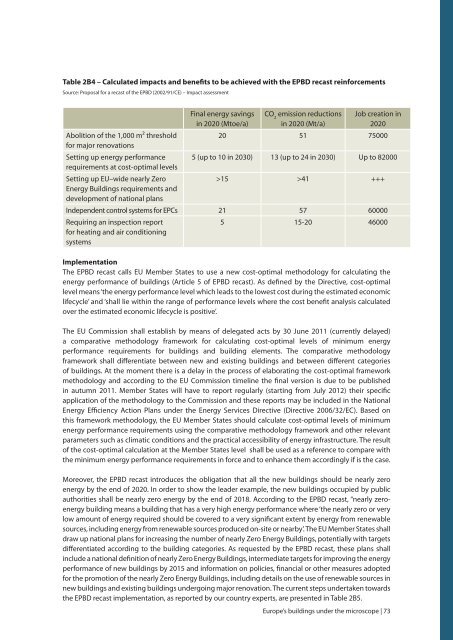BPIE: Europe's buildings under the microscope - PU Europe
BPIE: Europe's buildings under the microscope - PU Europe
BPIE: Europe's buildings under the microscope - PU Europe
Create successful ePaper yourself
Turn your PDF publications into a flip-book with our unique Google optimized e-Paper software.
Table 2B4 – Calculated impacts and benefits to be achieved with <strong>the</strong> EPBD recast reinforcements<br />
Source: Proposal for a recast of <strong>the</strong> EPBD (2002/91/CE) – Impact assessment<br />
Final energy savings<br />
in 2020 (Mtoe/a)<br />
CO 2<br />
emission reductions<br />
in 2020 (Mt/a)<br />
Job creation in<br />
2020<br />
Abolition of <strong>the</strong> 1,000 m² threshold<br />
20 51 75000<br />
for major renovations<br />
Setting up energy performance 5 (up to 10 in 2030) 13 (up to 24 in 2030) Up to 82000<br />
requirements at cost-optimal levels<br />
Setting up EU–wide nearly Zero<br />
>15 >41 +++<br />
Energy Buildings requirements and<br />
development of national plans<br />
Independent control systems for EPCs 21 57 60000<br />
Requiring an inspection report<br />
for heating and air conditioning<br />
systems<br />
5 15-20 46000<br />
Implementation<br />
The EPBD recast calls EU Member States to use a new cost-optimal methodology for calculating <strong>the</strong><br />
energy performance of <strong>buildings</strong> (Article 5 of EPBD recast). As defined by <strong>the</strong> Directive, cost-optimal<br />
level means ‘<strong>the</strong> energy performance level which leads to <strong>the</strong> lowest cost during <strong>the</strong> estimated economic<br />
lifecycle’ and ‘shall lie within <strong>the</strong> range of performance levels where <strong>the</strong> cost benefit analysis calculated<br />
over <strong>the</strong> estimated economic lifecycle is positive’.<br />
The EU Commission shall establish by means of delegated acts by 30 June 2011 (currently delayed)<br />
a comparative methodology framework for calculating cost-optimal levels of minimum energy<br />
performance requirements for <strong>buildings</strong> and building elements. The comparative methodology<br />
framework shall differentiate between new and existing <strong>buildings</strong> and between different categories<br />
of <strong>buildings</strong>. At <strong>the</strong> moment <strong>the</strong>re is a delay in <strong>the</strong> process of elaborating <strong>the</strong> cost-optimal framework<br />
methodology and according to <strong>the</strong> EU Commission timeline <strong>the</strong> final version is due to be published<br />
in autumn 2011. Member States will have to report regularly (starting from July 2012) <strong>the</strong>ir specific<br />
application of <strong>the</strong> methodology to <strong>the</strong> Commission and <strong>the</strong>se reports may be included in <strong>the</strong> National<br />
Energy Efficiency Action Plans <strong>under</strong> <strong>the</strong> Energy Services Directive (Directive 2006/32/EC). Based on<br />
this framework methodology, <strong>the</strong> EU Member States should calculate cost-optimal levels of minimum<br />
energy performance requirements using <strong>the</strong> comparative methodology framework and o<strong>the</strong>r relevant<br />
parameters such as climatic conditions and <strong>the</strong> practical accessibility of energy infrastructure. The result<br />
of <strong>the</strong> cost-optimal calculation at <strong>the</strong> Member States level shall be used as a reference to compare with<br />
<strong>the</strong> minimum energy performance requirements in force and to enhance <strong>the</strong>m accordingly if is <strong>the</strong> case.<br />
Moreover, <strong>the</strong> EPBD recast introduces <strong>the</strong> obligation that all <strong>the</strong> new <strong>buildings</strong> should be nearly zero<br />
energy by <strong>the</strong> end of 2020. In order to show <strong>the</strong> leader example, <strong>the</strong> new <strong>buildings</strong> occupied by public<br />
authorities shall be nearly zero energy by <strong>the</strong> end of 2018. According to <strong>the</strong> EPBD recast, “nearly zeroenergy<br />
building means a building that has a very high energy performance where ‘<strong>the</strong> nearly zero or very<br />
low amount of energy required should be covered to a very significant extent by energy from renewable<br />
sources, including energy from renewable sources produced on-site or nearby’. The EU Member States shall<br />
draw up national plans for increasing <strong>the</strong> number of nearly Zero Energy Buildings, potentially with targets<br />
differentiated according to <strong>the</strong> building categories. As requested by <strong>the</strong> EPBD recast, <strong>the</strong>se plans shall<br />
include a national definition of nearly Zero Energy Buildings, intermediate targets for improving <strong>the</strong> energy<br />
performance of new <strong>buildings</strong> by 2015 and information on policies, financial or o<strong>the</strong>r measures adopted<br />
for <strong>the</strong> promotion of <strong>the</strong> nearly Zero Energy Buildings, including details on <strong>the</strong> use of renewable sources in<br />
new <strong>buildings</strong> and existing <strong>buildings</strong> <strong>under</strong>going major renovation. The current steps <strong>under</strong>taken towards<br />
<strong>the</strong> EPBD recast implementation, as reported by our country experts, are presented in Table 2B5.<br />
<strong>Europe</strong>’s <strong>buildings</strong> <strong>under</strong> <strong>the</strong> <strong>microscope</strong> | 73
















